DNR set to plunge into water trails across Michigan
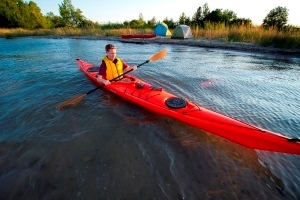 All across this Great Lakes State, there are trails for hikers and bikers, off-road vehicle riders, snowmobilers and equestrians. All across this Great Lakes State, there are trails for hikers and bikers, off-road vehicle riders, snowmobilers and equestrians.
For each of these pursuits, the Michigan Department of Natural Resources plays a big role in providing appropriate places for participants in these outdoor recreation activities to enjoy their passions.
Michigan has trails for boaters and paddlers too, but so far, the DNR has not been very involved in these water trails. That’s about to change in a significant way.
The DNR is in the process of developing a policy to include water trails – some overseen by other entities and some yet to be developed – into the state’s trail program.
Water trails range from segments of inland streams to Michigan’s entire Great Lakes shoreline. The policy is designed to help provide some consistency to user expectations of those trails.
"If they (paddlers or boaters) are reading about a water trail, they should know what to expect in terms of access and facilities along the trail and what skill-level is needed for each trail segment, be it along a river, inland lake or one of the Great Lakes,” said Emily Meyerson, the DNR Parks and Recreation Division’s northern Lower Peninsula trails coordinator who is working on the policy.
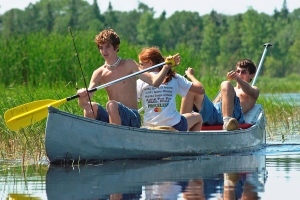 Developing a state system of water trails is one of the five goals of Michigan‘s Water Strategy, a 30-year plan to protect, manage and enhance Michigan’s wonderful water resources for current and future generations. Developing a state system of water trails is one of the five goals of Michigan‘s Water Strategy, a 30-year plan to protect, manage and enhance Michigan’s wonderful water resources for current and future generations.
Helping lead the charge is the Land Information Access Association, a 25-year-old nonprofit community development organization. The association began a program called Partnerships for Change to work on multi-jurisdictional projects.
Harry Burkholder, the association’s executive director, said the group immediately identified trails as “low-hanging fruit,” and water trails are an obvious corollary to land trails.
“There was no access to information on these water trails,” Burkholder said, “so we got a grant (from the Department of Environmental Quality’s Office of the Great Lakes) to create a database and website.”
Beginning with a handful of water trails that had been designated by a variety of entities, ranging from county governments and regional planning agencies to watershed groups and paddling clubs, the association now maintains a list and maps of 41 water trails situated throughout Michigan.
As part of its effort to promote water trails, the DNR sponsored an online contest to name Michigan’s favorite water trail.
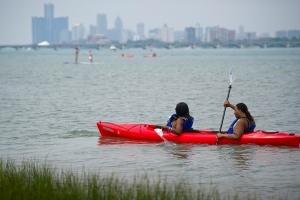 Of the 11 top vote-getters, the Au Sable River – which wasn’t even listed in the association’s database – was chosen by respondents as the top water trail in the state. Other nominees included the Shiawassee River, the Detroit River, the Grand River and Isle Royale National Park. Of the 11 top vote-getters, the Au Sable River – which wasn’t even listed in the association’s database – was chosen by respondents as the top water trail in the state. Other nominees included the Shiawassee River, the Detroit River, the Grand River and Isle Royale National Park.
Burkholder said there are other states that have moved more quickly than Michigan in developing and promoting their water trails.
“Wisconsin, Illinois and Indiana had already designated water trails on Lake Michigan before we did,” Burkholder said. “Now you can paddle on a designated Great Lakes water trail all around the state. But how well is that known? The awareness of these things is just not there.”
And that’s part of the impetus for the DNR’s policy: to foster awareness.
“What the heck’s the difference between a paddling route that anyone could take since the Great Lakes were formed to now that there are designated trails?” Burkholder asked. “It’s about broad-based partnerships taking ownership – providing maintenance, access sites, signage and awareness.”
Burkholder said Michigan and water trails are a perfect fit.
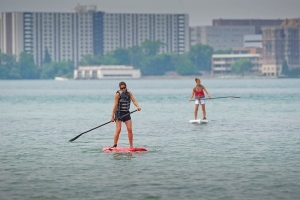 “For Michigan, it’s a no-brainer,” Burkholder said. “In these communities, the water resource is already there. We can be the epicenter of this kind of recreation. “For Michigan, it’s a no-brainer,” Burkholder said. “In these communities, the water resource is already there. We can be the epicenter of this kind of recreation.
“And it does benefit communities – the more we can create trails, it serves as an impetus for development. The state and most communities recognize the place-making and economic-development potential of trails. It’s just about how we can make it better.”
LIAA is currently working on a water trails manual for Michigan. Many of the details are still in discussion. Should there be, for instance, separate motorized and non-motorized trails?.
“The Inland Waterway, which goes from Cheboygan along the Indian River to Petoskey, is really one of those trails that has both the paddling perspective and the motorized perspective,” Burkholder said. “They can co-exist, obviously.”
The National Park Service has a program for designating national water trails. Two trails in Michigan, the Blueways of St. Clair (which finished second in the online voting) and the Huron River (fifth), are among the 18 on the federal water trails list.
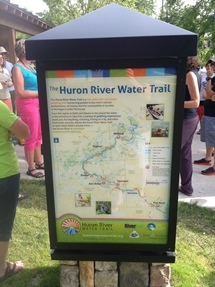 The National Park Service trails were designated at the first national water trails conference, which was held in Ann Arbor two years ago. That Michigan city was chosen as the conference site because of the grass-roots movement for water trails surrounding the Huron River, Burkholder said. The National Park Service trails were designated at the first national water trails conference, which was held in Ann Arbor two years ago. That Michigan city was chosen as the conference site because of the grass-roots movement for water trails surrounding the Huron River, Burkholder said.
Barbara Nelson-Jameson, an outdoor recreation planner with the National Park Service, said water trails – just like trails on land – must meet four criteria to be designated.
She said they must be open year-round for at least 10 years, must have the support of the landowners providing access, must meet all environmental and land-use policies and laws along the corridor, and must be maintained.
In addition, the trails are required to adhere to seven best-management practices that address recreation, public information, public support, maintenance, education, conservation and planning.
The Huron River water trail meets the criteria in spades, she said.
“The Huron River Watershed Council had a very comprehensive planning process where they brought all the communities and management agencies together to develop,” Nelson-Jameson said. “They developed public information that is uniform across all the municipalities; the signage is the same in Rockwood as it is in Ann Arbor. And they continue to monitor it. They’ve actually helped communities improve and enhance their launch sites.”
The Huron River Watershed Council also conducts watershed-wide conservation programs, such as water quality monitoring, working with partners, including school or community groups.
“They have a very robust program,” Nelson-Jameson said.
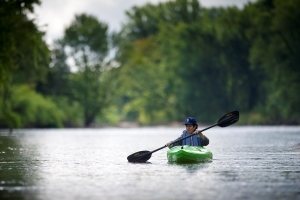 While the DNR is gathering feedback on its draft water trails policy, it has signed on with the Michigan Department of Environmental Quality and LIAA to sponsor a state conference, scheduled for Sept. 15 in Traverse City. While the DNR is gathering feedback on its draft water trails policy, it has signed on with the Michigan Department of Environmental Quality and LIAA to sponsor a state conference, scheduled for Sept. 15 in Traverse City.
"Our waterways have been used historically for both transportation and recreation," Meyerson said. “They’re looked at by the public as places to recreate, for paddling, fishing or just being outdoors. There is a lot of interest in water trails all over the state.”
"After the plan is completed, we will explore strategies to not only partner with multiple jurisdictions but seek a stable funding source for the development of water trails across Michigan."
Get more DNR information on water trails in Michigan.
Check out the National Park Service’s water trails list and other information.
Catch upcoming stories by subscribing to free, weekly “Showcasing the DNR” articles. Check out previous Showcasing articles.
/Note to editors: Contact: Emily Meyerson, 231-330-2795 or John Pepin, 906-226-1352. Accompanying photos are available below for download and media use. Suggested captions follow. Credit: Michigan Department of Natural Resources, unless otherwise noted.
Kayaker with tents: The Department of Natural Resources is developing a policy to include Michigan water trails in the state's trails program to help paddlers and boaters enjoy the state’s waterways.
Kayaker: Michigan water trails range from segments of inland streams to the Great Lakes shoreline.
Kayakers Detroit River: The Detroit River was chosen as one of the top water trails in the state in a DNR-sponsored online contest to name Michigan’s favorite water trail.
SUP: Michigan‘s Water Strategy, a 30-year plan to protect, manage and enhance the state’s water resources, includes the development of water trails as one its five goals.
Canoers: The Land Information Access Association, a non-profit community development organization, is working on developing a water trails manual and has created a website of water trails located throughout the state.
Huron River sign: The Huron River Water Trail is one of the two trails in Michigan and the 18 trails in the country designated as national water trails by the National Park Service. Photo courtesy of LIAA.
Tip of the Thumb sign: Part of the impetus behind the DNR’s development of a water-trails policy is to foster awareness of recreation opportunities in communities around the state. Photo courtesy of LIAA./
The Michigan Department of Natural Resources is committed to the conservation, protection, management, use and enjoyment of the state’s natural and cultural resources for current and future generations. For more information, go to www.michigan.gov/dnr.
|